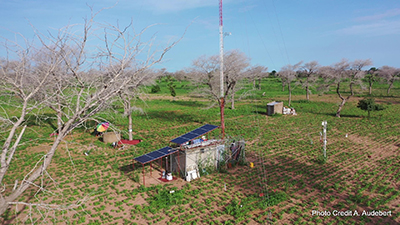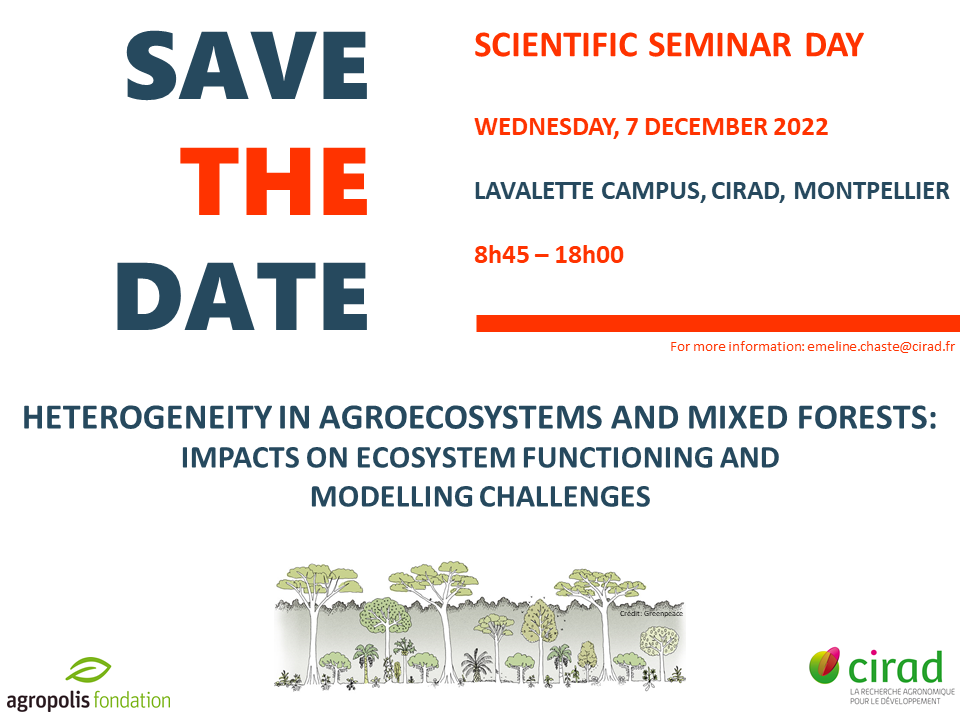 Towards climate impact of tropical agroforestry: from local data to global model
Towards climate impact of tropical agroforestry: from local data to global model
Abstract
A multitude of local experiments and various synthesis have identified agroforestry systems (AFS) as one promising of the nature-based solutions to help mitigating the climate crisis. Yet, little is known on the large-scale potential of AFS to tackle climate change. The main reason for this is the lack of Land surface Models (LSM) considering AFS ecosystems. The complexity and variability of AFS systems makes it difficult to implement them in LSMs that have strong surface homogeneity assumptions. For example, most LSMs represent vegetation as a single layer of biomass interacting with light, water and nutrients. Large scale modeling of AFS calls for a description of the structural heterogeneity of mixed ecosystem types and the biophysical and biogeochemical interactions that affect radiation interception, energy partitioning, water and nutrient fluxes.
In the DM-TropAFS project funded by Agropolis Foundation, we focus on the tropical AFS Faidherbia parklands as a proof-of-concept to include structural heterogeneity in the ORCHIDEE LSM. First, we upgrade the Faidherbia-flux observatory with equipment adapted to measure the surface energy budget under the canopy and in the open to provide validation data for the model. We develop the Agroforestry Functional Types (AFT) concept to describe worldwide AFS conciliable with the multi-tiling strategy under development in ORCHIDEE that allows flexible sharing of water and energy columns. The AFT concept is analogous and compatible to the Plant Functional Types (PFT) concept generally used in LSM to describe vegetation. Then we parameterize the ORCHIDEE model to represent the Faidherbia AFS by setting ecophysiological parameters for Faidherbia and its associated crops pearl millet and peanut. Finally, we simulate the Faidherbia ecosystem with the upgraded version of ORCHIDEE including a multi-layer energy budget to calculate the vertical distribution of heat fluxes and evaluate the impact of including this process for AFS modeling. Simulations results are compared at site level based on carbon, water and energy data collected at the experimental Faidherbia-flux platform before taking the simulations up to the regional scale.
The application of these developments to a well described semi-arid ecosystem will lead to the first validation of a global land surface model applied to AFS and pave the way to the evaluation of the large-scale climate potential of AFS, of relevance to inform climate and SDG policies.
Scientific seminar day

More information: click here
Implication for Eco&Sols
Project coordinator
Expected results
- A global database of Agroforestry types (AFT) at a level of detail usable by the global land surface model ORCHIDEE, that is including main ecophysiological parameters, locations, and available evaluation datasets.
- A new version of the ORCHIDEE model integrating the structural heterogeneity of AFT and their effects to the plant canopy energy budget.
- Maps of carbon, water and energy fluxes in the Faidherbia parklands under current climate and future climate scenarios.
- Build an interdisciplinary working group able to respond as a consortium to AFS-related calls.
Date
2022– 2024
Funding
Agropolis Foundation
Partners
UR Hortsys, CIRAD, France - https://ur-hortsys.cirad.fr/
UMR LSCE, CNRS, France - https://www.lsce.ipsl.fr/
LMI IESOL, IRD, Senegal - https://sites.google.com/site/iesolafrica/home
Contacts:
Aude Valade, UMR Eco&Sols, CIRAD, Montpellier
Emeline Chaste, UMR Eco&Sols, CIRAD, Montpellier
Damien Beillouin, UR Hortsys, CIRAD/CAEC, Le Lamentin, Martinique






